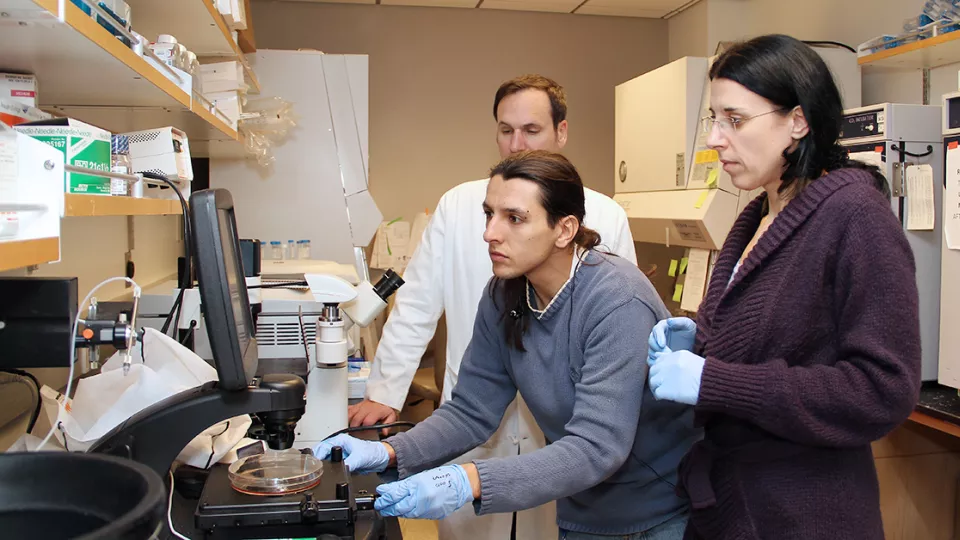
In children with progressive chronic kidney disease (CKD), loss of kidney function is for the most part irreversible.
“The glomerulus is where the kidney filters the blood,” says Laura Perin, PhD, co-Director of the GOFARR Laboratory for Organ Regenerative Research and Cell Therapeutics in Urology at Children’s Hospital Los Angeles. “When the glomeruli are not functioning, our kidneys are destined to fail. Patients’ only options are dialysis or transplantation as there is no direct therapy for preserving the glomerulus structure. Our patients with chronic kidney disease take medications for lowering blood pressure, but they have no medications that can specifically prevent degeneration of the glomerulus.”
As a result, the glomerulus irretrievably loses its working podocytes, the specialized cells that filter waste and maintain the body’s fluid balance.
Dr. Perin and Stefano DaSacco, PhD, are co-Principal Investigators on a new five-year award of $3.2 million from the National Institutes of Health (NIH) to research the underlying mechanisms that lead to kidney failure and to develop new treatments to protect kidney function.
“When you lose enough podocytes, over time your kidneys will not filter anymore,” says Dr. Perin, who is also an Associate Professor at the Keck School of Medicine of USC. “These podocytes are among the few types of cells in our body with a very scarce probability of regeneration.” When the podocytes cease to function, they die and are lost in the urine. GOFARR researchers believe that kidney failure in CKD could be avoided if there is a way to protect podocytes.
The GOFARR lab is also sharing a two-year NIH $2 million award with collaborators to further develop the lab’s kidney-on-a-chip high-throughput screening platform for testing medications for chronic kidney disease. Dr. Perin is the Principal Investigator on this grant. “We are studying the molecular mechanisms that regulate chronic kidney disease by focusing on the role of the microRNA in podocyte biology,” says Dr. Perin. “We are using the organ on a chip as a tool.”
Targeting podocyte influencers

A microRNA is a tiny piece of RNA that can be used to control protein expression in cells. The researchers are investigating how changing the levels of a specific microRNA called miR-193a could “reset” the molecular signaling networks that affect how podocytes function. Understanding and regulating the interactions between these cells could help develop a therapy to protect podocytes.
The latest NIH grant will enable the GOFARR lab to investigate how manipulating the levels of miR-193a could “re-program” the molecular signaling networks that influence podocyte function to protect them from ongoing damage. In collaboration with the lab of Eun Ji Chung, PhD, the Dr. Karl Jacob Jr. and Karl Jacob III Early Career Chair and Assistant Professor of Biomedical Engineering, Chemical Engineering and Materials Science, Surgery, and Medicine at USC, the GOFARR researchers will use nanoparticles to target miR193a in an animal model with a type of CKD called Alport syndrome.
Dr. Perin notes that this clinical work involves studying the fundamental mechanisms that cause CKD progression, as well as developing strategies for therapeutically targeting the glomerulus with minimal side effects.
“This will be one of the first kinds of therapies designed to just work within the glomeruli,” Dr. Perin says. “We are actually targeting one specific cell type in this model of Alport syndrome that is the culprit of this disease, so everything is designed just to preserve the function of these cells.”
Artificial kidney-on-a-chip
Developing medications that directly target CKD has so far been hampered by the lack of reproducible in-vitro models of the kidney. The GOFARR Lab’s kidney-on-a-chip will be used to find biomarkers—measurable indicators in the body that can guide the discovery of targeted new medicines.
This tool created by GOFARR researchers is a chip with surface compartments loaded with living kidney cells that serve as a glomerular filtration barrier to test potential medications in the laboratory. “We recreated the glomerulus for drug screening,” says Dr. Perin.
The kidney-on-a-chip platform is intended for the scientific community and pharma to screen potential new medications as well as to model glomerular filtration barrier dysfunction in other CKDs, including membranous nephropathy, diabetic nephropathy and APOL1 nephropathy. “We are studying three or four different types of chronic kidney diseases,” says Dr. Perin. “The more you study a disease from different angles, the more you can understand the disease.”
